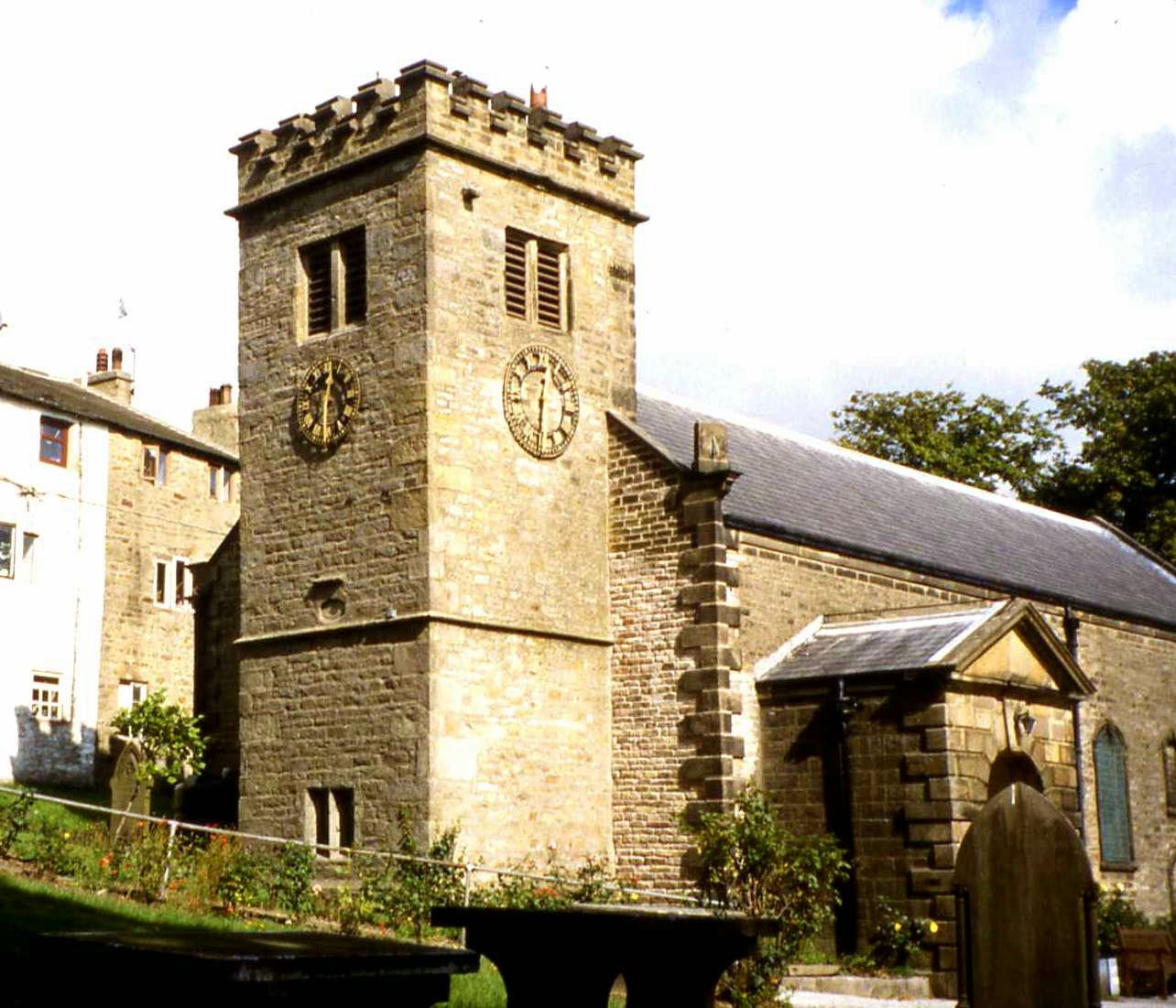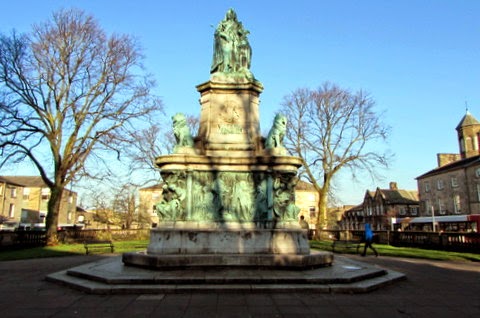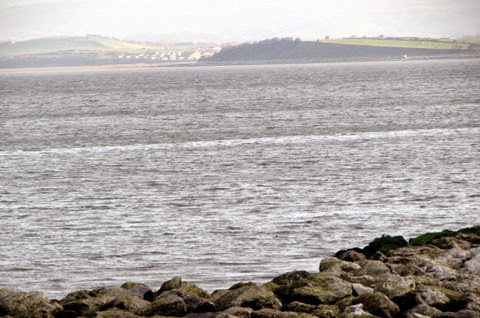The Parish Church at ORMSKIRK in south-west Lancashire is unique in that it has tower and a steeple at the same end. Local legend says that two sisters were unable to agree whilst building the church and settled for
a tower and a steeple.
a tower and a steeple.
The facts are that the steeple was actually built in 1430 being re-built in 1790 and in 1832, whilst the tower was built in 1570 to house the bells from nearby Burscough Priory at the Dissolution.
BLACKPOOL is Lancashire's premier seaside resort. With its famous boarding houses it has long been the destination of the working classes who flocked here for their annual holiday when the cotton and woollen mills of Lancashire and Yorkshire closed for the 'Wakes Week' to allow this pilgrimage in the late 19th
and early 20th centuries.
With seven miles of sandy beaches, three piers and its Golden Mile of pleasure emporiums, over 6 million visitors return to the resort each year to this Capital of Entertainment which has kept to the forefront of British holiday towns.
The iconic Blackpool Tower is one of the best known buildings in the UK.
Inspired by the Eiffel Tower in Paris, it was opened in 1894. A Grade 1 listed building, it rises 518 feet 9 inches (158.12 metres).
The base contains a number of attractions including the famous circus and the tower ballroom, whilst there is a popular viewing platform on top.
The base contains a number of attractions including the famous circus and the tower ballroom, whilst there is a popular viewing platform on top.
The Comedy Carpet, situated opposite the Tower, was laid out in 2011 showing jokes and punch lines from comedians who have performed in Blackpool over the decades.
A pub on the promenade next to the Tower, reminds us of Stanley Holloway's famous monologue about young Albert Ramsbottom and his encounter with the lion at Blackpool Zoo.
" There's a famous seaside place called Blackpool that's noted for fresh air and fun and Mr & Mrs Ramsbottom went there with Albert their son ......."
Some six miles of illuminations have been a major attraction to the town every autumn and dubbed the 'greatest free light show on earth' never fail to shine.
The tiny village of WYCOLLER is situated in a lovely area of
Lancashire known as the Forest of Trawden and close to the West Yorkshire
border not far from Haworth of Bronte fame.
There has been a settlement there as far back as 1000BC. It was essentially an agricultural village
until the 18th century when the manufacture of woollen and worsted
on handlooms became the prominent industry.
In 1820 the population of Wycoller was 350 but the 35 dwellings soon
became deserted as people left to seek more lucrative employment in the mills
which had brought prosperity to nearby towns with the coming of the industrial
revolution.
Late in the 19th
century there was a proposal to flood the valley and Wycoller to create a new
reservoir and the village became totally derelict. Eventually the scheme was abandoned and in
1973, Lancashire County Council purchased the land which they declared a
conservation area, with 350 acres of the surrounding countryside being
designated a Country Park.Now much of the village has been restored. Once again the cottages are inhabited and the community is thriving once again after more than 100 years.
The ruined 16th century Hall is said to be the original 'Ferndean Manor'
in Charlotte Bronte's 'Jane Eyre.
The nearby PENDLE HILL country reminds us of the awful superstitions of and up to the 17th century
The belief in witchcraft dates back to time immemorial. A witch was a person who practised sorcery, having supernatural powers to work with evil spirits or the devil. The term was applied to anyone who had remarkable or inexplicable means of accomplishment. It is said that between 1484 and 1782, at least 300,000 witches were put to death in
It was firmly believed that witches and warlocks could be
deprived of their powers by drawing blood and that their bodies had an area
that was sensitive to pain but would not bleed.
Indeed, a whole profession of ‘witch pickers’ grew up, touring the
country to identify witches and sometimes they themselves were convicted of the
very crime they were supposed to expose.
A popular method employed was ‘the swimming of a witch’, which entailed
the suspect being lowered three times into the water with the right thumb tied
to the left big toe. If the suspect
floated, he or she was guilty of witchcraft.
In England
In 1612, ten alleged witches from the Pendle area were sent to the scaffold under James 1’s new laws against witchcraft. These women and their alleged victims resided in the villages and farms surrounding Pendle Hill, which at 1832ft is a distinctive landmark in this picturesque area, although few traces of their existence remain today.
In the churchyard at NEWCHURCH there is an old gravestone referred to locally as 'The witches grave', because of the name ‘Nutter’ and a skull and crossbones thereon. A smaller stone close up to the wall of the church is more likely to be the grave of one of the convicted women, Alice Nutter. Old Demdyke and Chattox, another two of the alleged witches were said to have robbed the graveyard at Newchurch, because bones and clay effigies were found in their homes. Apparently all the women freely confessed to being witches when tried at Lancaster Castle.
The church at Newchurch has an unusual ‘eye of God’ built into the fabric of the tower, which is said to have provided additional protection from the evil that once seems to have afflicted these parts.
An old cottage in Halfpenny Lane
An unusual family tomb can be seen in the lovely church of St Peter St Paul BOLTON-BY-BOWLAND .
It commemorates local Lord of the Manor, Sir Ralph Pudsay (died 1468),
his three wives and twenty five children! The figures of each one of the family are
carved in relief on the huge grey marble slab, together with the names of each
of the 25 children
A village which claims to be the centre of the British
Isles has support from
both the National Grid and British Telecom.
The 100,000th payphone box stands on the village green at DUNSOP BRIDGE
LANCASTER is the county town of Lancashire. It stands on the River Lune in the north of the county and is dominated by its Castle of Norman foundation.
The 15th century Priory Church of St Mary is nearby.
The Grade 11 listed Town Hall was opened in 1909 by local business man Lord Ashton who financed the building.
Lord Ashton paid £155,000 which included the erection of a very fine statue of Queen Victoria which still stands proudly in Dalton Square
opposite the Town Hall.
The base of the statue has amazing relief panels on four sides of the Government Ministers as well as other notable figures of the period.
Lord Ashton was a very rich man and perhaps his greatest extravagance dominates the area for miles around Lancaster.
The Ashton
Memorial is situated in Williamson Park high above the town and has been described as England’s grandest folly and is often
referred to as the Taj Mahal of the North. It was built between 1907 and 1909
by millionaire industrialist Lord Ashton in memory of his wife. It cost a
staggering £80,000 to build – the equivalent of more than £4,500.000 in today’s
money. It was designed by John Belcher in the Edwardian Baroque style and at
150 feet tall it dominates the local skyline. Built from Portland stone with a
copper dome, the exterior of the building has sculptures representing Commerce,
Industry, Science and Art. The interior floor is of black, white and red tiles
with allegorical paintings inside the dome.
It was damaged by fire in 1962 and
restored in the mid 1980’s.
The building is freely accessible and fine views of the surrounding area are to be had from the balcony.
The Edwardian Palm House is now a Butterfly House.
Its wide bay with its long promenade and spacious beaches have long been popular with visitors from the nearby industrial towns.
Well loved comedian, John Eric Bartholomew OBE was born at Morecambe in 1926 and took the stage name of Eric Morecambe when he became part of the much loved comedy duo Morecambe and Wise. The Morecambe and Wise Show was an award winning double act which lasted from 1941 until Morecambe's death in 1984.
A larger than life statue of the comedian was unveiled by the Queen on the promenade at Morecambe in 1999. It was surrounded by inscriptions of many of his favourite catchphrases together with lists of guest artistes who had appeared on the Morecambe and Wise Show
Sadly in October 2014 the statue was vandalised when someone sawed the standing leg off and the statue had to be removed for repair.
The man responsible was detained under the Mental Health Act.
The repaired statue was subsequently re-instated in December 2014.
Morecambe Bay. The railway station was famously used as a location for the 1946 film 'Brief Encounter'.
Although the main line is still in use, part of the station has been restored and is now an award winning Heritage Centre and the 1945 refreshment room is exactly the same as it was when Brief Encounter was filmed.
The iconic late 19th century station clock also played a prominent role in the film. The fully restored clock is mechanical and is wound by hand on a weekly basis.
A simple stone slab
marks a lonely grave on the water’s edge at SUNDERLAND POINT overlooking Morecambe Bay.
'
Here lies Poor Samboo
A faithful Negro who (attending his mafter
from the Weft Indies )
Died on his arrival at Sunderland
1796'.
A nearby jetty was where cotton, first brought from the West Indies , was unloaded en route to the Lancashire mill towns.
HEYSHAM is an historic village overlooking Morecambe Bay. Grade 1 listed St Peter's church stands on a Saxon foundation,on a headland above the village with spectacular views over the bay.
The nearby ruin's of St Patrick's chapel are thought to date from the 11th century. Local legend has it that St Patrick landed here after crossing
from Ireland.
from Ireland.
Alongside, rock hewn graves are believed to be amongst the earliest examples of Christian burial in the country.
NEXT STOP - ISLE OF MAN





























.JPG)



.JPG)

.JPG)
.JPG)
.JPG)
























No comments:
Post a Comment